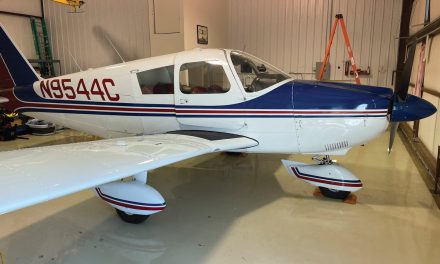In the previous tutorial, we discussed how your electrical system works. Now we will be discussing how your electrical system might not work. In this tutorial, we will cover the most common problems experienced with the electrical system of the typical single engine airplane.
Since only much older airplanes are equipped with generators, I will default to the alternator for the remainder of this tutorial. Except for a few differences, generators work the same as alternators. Any differences will be addressed when needed.
Testing Your Electrical System Before Takeoff
Sometime after engine start, test your alternator to make sure it is online and operating properly. Monitor the ammeter or load meter, also known as an amp meter, then turn on several high-demand items such as pitot heat, landing lights, etc.
Test With a Load Meter
With a load meter, you should see an increase in amps commensurate with the items being used in the test. A load meter reading of zero, with the engine running, indicates the alternator is offline. First, increase rpm to see if it was simply below cut in speed, especially if you have a generator or a 28-volt alternator. If the load still shows zero amps with the engine well above 1000 rpm, follow POH guidance for resetting the alternator.
Test with an Ammeter
If you have an ammeter, digital or analog, turning on high-demand electrical items should result in nothing more than a momentary flicker of the needle, then it should return to zero or just slightly to the right of zero. If you see a continuous discharge under a load, the alternator is not working properly. Any abnormal indication with either kind of meter should be investigated prior to taking off.

Tripped Circuit Breakers
A circuit breaker can trip for two reasons: a simple overload, or a short circuit, aka a ground fault. If the tripping of a circuit breaker was caused by an electrical short, a serious threat to the safe continuation of a flight has just been averted.
Remember, circuit breakers trip by sensing the heat generated by high current flow. This heat could be the result of either an electrical short, or an item associated with the breaker demanding more power than normal. Since it is difficult to tell why a circuit breaker tripped, be very careful about resetting it.
A tripped circuit breaker should never be reset more than one time. The continuous resetting of a tripped circuit breaker may get it so hot it could weld the breaker’s internal tripping mechanism, thus preventing it from tripping again. If this happens, an electrical fire is almost certain, and here is the proof.
Many years ago, the pilots of an Air Canada DC-9 reset the circuit breaker for a toilet flush motor several times, but on the last reset, the pilot held the breaker in for a few seconds. This caused the breaker to become welded in place resulting in an electrical fire that destroyed the airplane on the ground after a successful emergency landing.
The lessons to be learned are twofold: Never reset a circuit breaker multiple times, and never hold a circuit breaker in an effort to get it to reset. Always follow the guidance in your POH for resetting circuit breakers or replacing blown fuses. If no guidance is provided, limit resets to one time.
Alternator Failure
It is important to know what a normal indication is on either a load meter or an ammeter so that you can quickly spot an abnormal indication. For ammeters, once the battery is fully charged after engine start, a normal reading would show the gauge’s indicator on zero, less than one needle width to the right side of zero, or slightly above zero with a digital display.
Any other indication would be abnormal. If you have a load meter, a normal reading would be about 20-25 amps, depending upon how many electrical devices are in use. Here is how an alternator or generator failure is indicated:
- The low voltage light is on
- The ammeter shows a continuous dishcarge
- The load meter shows zero amps
If the alternator or generator is offline during ground operations again, first increase engine rpm to make certain it was not simply below cut in speed, especially if you have a generator or 28-volt alternator. If the alternator or generator is still offline, most POHs will tell you to turn the master switch off for two seconds, then back on. If a reset is done, and the ammeter still shows a discharge, or the load meter shows zero amps, you will have 30 minutes or less of battery power before the lights go out.
Partially Discharged Battery: Doing the Math
Let’s say you turn the master switch on and see your battery is discharged and showing just 10 volts. The airplane’s battery relay, which connects the battery to the electrical system, requires about 9 volts to close and to stay closed. If battery voltage drops below this value, the battery relay will open, taking the battery offline. Doing the math, you can see you don’t really have 10 volts. You only have 1 useable volt before the battery relay opens.
It is critical to understand that if the alternator has failed in flight, and you are operating on battery power only, it will drop offline at some point when its voltage drops below 9 volts.
Dealing with a Completely Dead Battery
If your battery is completely dead, or almost so, it should be fully recharged before taking off. The safest method is to remove it from the airplane and use a battery charger in a well-ventilated area.
Here’s why: A deeply discharged battery will have a very high initial charge rate from the alternator or a ground power source. This rapid charging produces hydrogen gas which can collect near the battery. One tiny spark could lead to an explosion, especially if your battery is mounted in a confined space, such as behind the aft cabin bulkhead or in the tail. This is why the safest method is to remove the battery from the airplane and recharge it in a well-ventilated area.
Using External Power
After entering the cockpit to start the pre-flight inspection, it hits you. One of the pilots in your partnership left the master switch on after his or her last flight and the battery is now completely dead. What to do? Hand propping the engine to get it running comes to mind. However, as simple as it may seem, this might not work out as planned. If your airplane is equipped with an alternator, once the engine is running from a hand prop, it will soon be discovered the entire electrical system is still completely dead!
Then you recall the alternator needs a small shot of voltage from the battery to get it online and the completely dead battery could not meet this requirement. It would have worked with an old-fashioned generator, but not with an alternator.
The next option is to connect an external power unit into the receptacle on the fuselage. If this method is used, be sure to leave the ground power cable connected long enough to charge the battery sufficiently so it, in turn, has the 9 volts necessary to close the battery relay and then, in turn, to excite the alternator once the engine is running.
But even if you get the engine running and the alternator online, you would be taking off with a nearly dead battery. Keep in mind, the battery is a backup power source for the alternator or generator. Departing at night, into IFR weather, or into Class B airspace and having the alternator fail right after takeoff could result in an emergency situation. Assuming a safe landing is made, a call from the FAA may be in the offing. This can be avoided by having a fully-charged battery before takeoff.
The rest of this article and the specifications for the 1978 Piper Lance II can be seen only by paid members who are logged in.Have a website login already? Log in and start reading now.
Never created a website login before? Find your Customer Number (it’s on your mailing label) and register here.
JOIN HERE
Still have questions? Contact us here.
For questions, comments, corrections, or just to yell at me, feel free to contact me at:
Joel Turpin
Jturpin782@aol.com





